At DSEI in London, Leonardo UK spoke about their Proteus aircraft, detailing recent demonstrations of its autonomous capability in synthetic ASW trials and stressing that the current airframe is only a low-cost testbed for the technology rather than the final product.
The company was keen to point out that its Proteus demonstrator is “not…someone sat in a cabin somewhere with a joystick” but rather a roadmap to true autonomy, able to plan routes, avoid threats, collaborate with other aircraft, and execute missions without constant human input.
Nigel Colman, Managing Director Helicopters UK, Leonardo, tied the project directly to the Royal Navy’s own doctrine. “This is about the Royal Navy’s maritime aviation transformation strategy… crewed only where possible, uncrewed wherever possible. That’s where Proteus fits in.”
Proteus has been in development with the Ministry of Defence and Defence Equipment and Support since 2013, but Colman emphasised its agile, adaptive approach rather than rigid milestones.
The current £60 million phase has focused heavily on autonomy, with synthetic trials showing three Proteus systems detecting a submarine threat, sharing information, and allocating tasks amongst themselves. “We’ve demonstrated that to the Royal Navy at senior level,” he said, describing the autonomy package as the “brains” inside a temporary “body.”
Leonardo put particular weight on the synthetic trials already completed, presenting them as evidence that Proteus’ autonomy is not hypothetical but working now. Colman explained that “we’ve done some really good synthetic demonstrations, which includes real hardware, you know, the real software that we have flown in the synthetic environment. So we have flown three Proteus so far, together, collaboratively.”
He stressed that these systems were given an ASW mission to “find, fix and kill the submarine,” and that the aircraft then “communicated amongst themselves, decided which asset is best to deal with…that potential threat or issue, and allocated threats accordingly.” This, he said, had already been shown “to Royal Navy at senior level in recent months” and was described as “a really impressive capability.” The message to reporters was clear: the brains of the system are the real achievement, and they have already been proven in simulation, rather than being a distant aspiration.
At the same time, the company was careful to downplay the physical airframe shown at the briefing, framing it as a temporary and pragmatic solution rather than the end product. Colman told journalists that “this is not what a Proteus would look like in the future…Fenestron and tail rotors are probably not perfect in a really high sea state, high winds on the back of a ship in the North Atlantic. This is not an ideal platform, but it’s low risk, it’s low cost, and it gives us the opportunity to test the technologies and the autonomy.”
He added that “the brains is the important bit and where we’ve been focusing,” making clear that the value lies in the autonomy package rather than the demonstrator itself. “My view has always been that we don’t actually need to fly this particular anything, because we can fully test the digital twin and the important autonomous bits in a single, better synthetic environment,” he said, before conceding that “our customer and our partner wants us to do that, so we fly.”
The company’s aim is to ensure that coverage reflects Proteus as a step on the path to a future family of autonomous systems, rather than this specific aircraft being mistaken for the final product. The emphasis was on modularity. Large side panels conceal spaces where NATO pallet-sized payloads can be swapped in and out, allowing the system to handle anti-submarine, anti-surface, ISR, search and rescue, or even early warning missions.
Leonardo position Proteus as a response to the need for affordable mass in anti-submarine warfare. Uncrewed systems could stay on station longer than a Merlin, without the limitations of aircrew fatigue. They also reduce manpower requirements at a time when naval aviation is struggling to sustain numbers.
Asked about future milestones, Colman confirmed that the prototype is built and due to fly this year following ground runs. He admitted that the real capability lies in the autonomy software rather than the specific demonstrator aircraft. “If you’ve got the right autonomous software and the right accreditation, you can put that into anything,” he said, pointing to Leonardo’s wider portfolio from light Wildcats to the 16-tonne AW101.
The company also positioned the work as sovereign and exportable, noting efforts to keep it ITAR-free and relevant to overseas partners such as Japan. The cultural challenges of shifting the Fleet Air Arm toward uncrewed systems were acknowledged, but Colman argued the trajectory was clear. “I can’t imagine putting 30 people in the back of a Merlin without a pilot, that would be crazy. But times are changing. The hybrid carrier air wing concept is what we’re aiming for.”
It seems to me that Leonardo is moving the conversation away from any single drone and toward an inevitable shift in naval aviation, with autonomy as the decisive technology. It’s hard to argue with that.


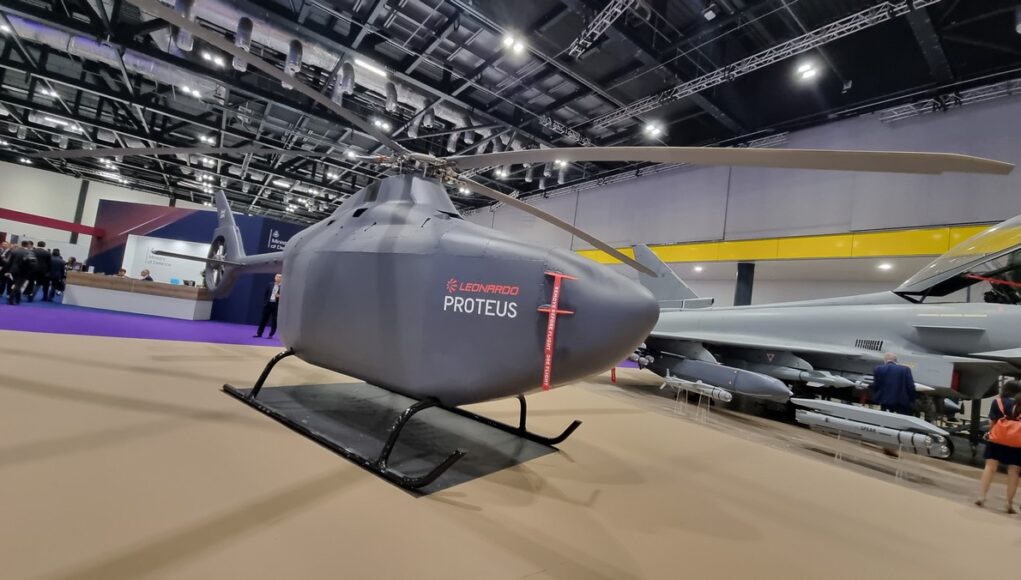
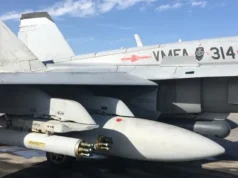

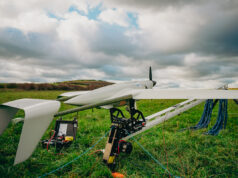
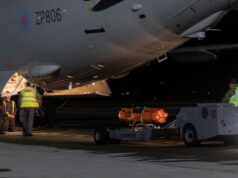

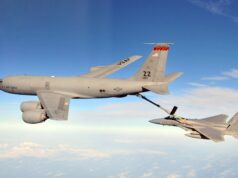
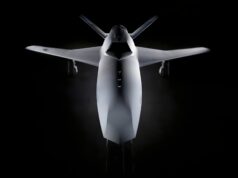

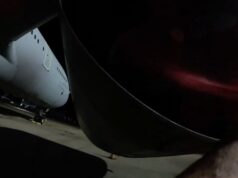
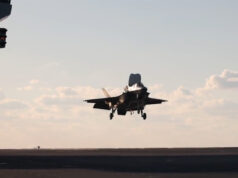

That’s a very defensive response from Leanardo, so they took all our money for a demonstrator to replace Merlin and spent it all on their own proprietary software then at the last minute chucked the software into a hobby helicopter airframe.
And this is going to replace crows nest in four years.
This was never going to be a Crowsnest replacement, but I agree with you, that this is about a product that flies off a ship and not a family of digital simulations in virtual space. If this doesn’t convince in the real world, Navy support will disappear until Leonardo takes product seriously.
Several years ago Proteous was being directly touted as the Crowsnest replacement. Now it’s been downgraded to no even a tech demonstrator but a software exercise.
Crowsnest is due to be gone in four years and it took nearly a decade to move it from one helicopter to another. There is no other available option anywhere in the world that can be available by 2029.
I think we could feasibly have AEW Protector STOL inside 4 years but that would require a decisive intervention from the MoD in their own procedures, and an acceptance of risk.
Protector might be a AEW asset but it’s likely to be limited in the AWACs capacity with a smaller radar. Proteus was suppose to bring a more powerful radar. Combined it’s a great combo but on its own Protector will struggle to replace Crowsnest
Not necessarily, MQ9B’s engine produces 712kW and AW09 (Proteus’ parent helicopter)’s does 750kW with the added requirements of, you know, having to directly lift itself into the air the whole time.
Add in increased altitude, endurance and airframe size and MQ9B will be a significantly more capable AEW aircraft than Proteus. It’s not surprising, it’s really a very small helicopter, but there’s no hope of it replacing Crowsnest. Perhaps a second line AEW aircraft to deploy from escorts is a more viable role?
If we take Leonardo at its word, that you can put their autonomy software in anything, maybe the best option is an autonomous Merlin with a properly powerful radar. Similar to what was offered a decade ago by Lockheed Martin, but perhaps with the GCAP radar. Crowsnest as it should have been, but without the people and with satcom to the host ship or even the UK for C2.
I thought Proteous was a done deal for the FAA, acting as the find segment augmenting Wildcat and Merlin?
Apparently not, it’s just a software program now.
Proteous was suppose to have a modular mission bay but apparently that’s not needed.
Some how I think the first sea lord is smoking c***k if he thinks he is getting drones on ships by next year.
As I recall it, the original idea of iteration 3 of the RWUAS was to design a purpose-built drone, taking advantage of the fact that there were no people to create something better than a helicopter conversion, which had already been done with the unmanned Solo. Again going from memory, Leonardo tried to kickstart the design phase themselves without waiting for MOD, and it didn’t happen. MOD caught up, put in £60m, and we ended up with all the radical new designs being pared down to what amounted to another helicopter conversion, this time based on the AW09, although I think is was more of a chimera than that. It was explained as leveraging existing technology. I felt that was a bit of cop out for a technology demonstrator programme. Nevertheless, they were adding modularity, which was not too shabby an idea.
Now we seem to be being told, they can’t even convert a helicopter and what they have built is unfit for purpose. Who cares if a Fenestron and tail rotors aren’t perfect in a high sea state? Who told him to design it that way? And who said it has to be perfect? We are all about iterating off the minimum viable product these days. In silico is not that. The Navy have to turn technology into capability and they need a product around which to do that. If I were in Navy technology office, right now I think I’d be knocking on the door of the USN to see if they kept any of the MQ-8Cs they retired to see if we could have some.
However disappointing after all the hype, it’s not the end of the world. RWAUS CCD phase 3 TDP really is just another demonstrator, for all that we (I) hoped it would be a prototype and close to a finished product. The demonstrator that will fly this year, if only because the Navy rightly insist that it must, is only a few months over time, unlike most MOD projects, and may well be within budget. The project holy trinity: time, cost and quality, has lost out on quality, and if Leonardo hadn’t hyped this up over that last three or four years it would be seen as the partial success it probably is, with MOD being blamed as usual for lack of ambition in not setting a more useful endpoint.
MOD now need to make a decision whether they iterate whatever Leonardo have come up with to get the product that they need. No more demonstrators! No more four-year test phases. A possible six month redesign phase if it really isn’t fit for purpose, followed by a one year build phase to deliver a fully working prototype that lives up to the hype. And even if the extra money won’t appear before April next year, the decision should be made immediately after the flight.
We all know there’s no money in Defence right now, so it’s going to be up to Leonardo to help out with some of the funding and putting in place a project manager who isn’t about developing new technology and instead is about developing a product line that they can sell.
So that fancy future RN chart showing all the new types for find, fix Strike, and all the rest, was yet more informing decisions and greater understandings.
I forget its name now.
There was even a Drone in there that looked a bit like a Chinook.
More grandstanding cobblers from MoD then.
One of the early concepts for Proteus looked like a Chinook, the better to fit in the central payload module.
I can only recall that chart that UKDJ showed about future maritime aviation.
All glossy, designed to draw people in!
Where is the substance?
You seem to expect a great deal out of a 60 million pound technology demonstrator programme.
In the previous phase MOD and Leonardo jointly invested £8m and ended up with a drone converted from a Solo. I think I expected more this time when the MOD’s input alone was £60m. Am I really expecting a great deal?
Check out this press release still available on the Leonardo website: leonardo.com / en/press-release-detail/-/detail/21-07-2022-the-future-of-uk-uncrewed-military-vtol-technology-is-secure-onshore-as-mod-gives-green-light-to-leonardo-for-proteus-demonstration-flight
Leonardo promised to deliver a dual-use prototype adaptable for a wide range of uses in the military and commercial spaces. We’ll have to wait to see what Leonardo actually deliver. Coleman’s comments devastatingly downplay it, but maybe he just went OTT on managing expectations.
No. Proteus was never “touted” as a Crowsnest replacement.
AEW was one of the 16 mission types that were to be investigated during the program but not as a Crowsnest replacement.
BTW, Proteus is not marinised so is not capable of Naval use.
Crowsnest shouldn’t have ever been made. We should have had a proper early warning system in place by the time the carriers were made given we had 20 years to do so and so wouldn’t have needed to spend 640 million on a 5 year temporary solution.
The proper AWAC is being made, the MQ-9 by General dynamics with a Saab radar. Both companies working to produce it. It’s a good platform for the job, 40 hour endurance, capable of carrying the radar used on the global eye (though not sure whether it will be that radar), and it has already proven it can take off from the QE.
Makes sense, the autonomous software was always going to be the hardest part of this to develop.
Final hardware, not the current proving airframe, should be relatively easy…
That’s said, I noted the comment
“Fenestron and tail rotors are probably not perfect in a really high sea state, high winds”
Which suggests they want a NOTAR design. However Leonardo don’t currently have any helicopters using a NOTAR in place of a tail-rotar.
If the hardware is all that easy, why didn’t they do it?
The hardest part will getting anything operational on two ships. Having a helicopter on a frigate is a no-brainer. Nobody says should we, they just ask which. At some point in the future the won’t ask should we have a UAV, they’ll just ask which, and to reach that point we have to get some UAVs running on our frigates, and it almost doesn’t matter which.
The reason why anything is or isn’t done commercially, money. They’ll have aimed to fulfil the terms of the contract, the obvious primary deliverable being the software. With synthetic testing they’re able to test the software’s ability to ‘find, fix, kill’ many thousands of more times than they would actually be able to do it real-life. They probably automated the testing too, allowing for a scale of testing that would take many years to be done in real life using with ships.
But now that’s done, they need to verify in the real world, with the final airframe, as authentic testing is not enough. The question is whether funding is available for the next stage.
Given they’re a helicopter company, the hardware is the easiest part. 🤦🏻♂️
Then why didn’t Leonardo say that’s what they were doing three years ago? Why did we see teasers for tandem-rotor designs and in-wing fans dusted off from Project Zero? We went to them as a helicopter company and they haven’t given us a helicopter! If Leonardo UK is still a helicopter company that can do from scratch designs and all the brains haven’t been hived off to Italy, why aren’t they at least contributing that to this project? Why isn’t there commercial as well as public funding?
It only makes sense to concentrate exclusively on autonomy if that’s the end goal. It’s not MOD’s end goal even if it’s Leonardo’s. They can’t expect more and more UK money if all they intend to do is take the software we paid for and put it in the partly autonomous AWHero for Italian benefit, leaving the UK with not even a viable UAV design. (We know they have form.)
If there’s a next round and we don’t just end up buying American, can Leonardo be trusted to deliver for the UK and not just for themselves?
Pretty sure Leonardo aren’t answerable to you, unless you’re the Defence Secretary.
Have you seen the contract with the RN? Do you know what they were contracted to deliver?…
The answer is “no”, and you so you’re whinging and whining because the public relations spiel (which isn’t a contractual list of deliverables) led you to do 2 + 2 = 64 and assume a fully functional real-world system would be ready by now.
Personally I don’t care if they then use the AWHero as the hardware platform so long as it’s capable for what the RN wants. Though it seems unlikely they would use it as the AWHero has a tail rotor – I assume you actually read the article and noticed the surprising quote about not having a tail rotor…
As far as I’m aware Leonardo (Westlands as was) have never developed a coaxial helicopter or one similar to the NOTAR MD500 series. Apart from the Zero VTOL aircraft, which really can’t be classed as a helicopter, the only option I’ve heard of is the Next Generation Rotorcraft, where they are working in collaboration with Airbus on a development of the Racer compound helicopter. Which uses a pair of wing mounted propellors for yaw control as well as providing the thrust, instead of a tail rotor and using the main rotor to provide the thrust.
The Eurocopter Dauphin 2 which has a fenestron, can operate from a ship at sea state 6, which is no different to a Merlin. So I’m not sure what sea state Leonardo are considering?
I thought Leonardo were working with Bell on a tiltrotor for Next Gen, and Airbus were partnering with RTX.
I think you’re correct on the tiltrotor, as Bell and Agusta (Leonardo) have worked together on the AW609. So it would make sense to look at the Bell MV-75 (V280 Valor), especially as it significantly beat the SB1 Defiant in the tests. I believe RTX are working with Airbus to deliver a hybrid propulsion system for the Airbus compound aircraft.
Not true per se – you may find this link useful background interest – it was many years ago and to be fair to Westlands they were being very forward thinking at the time but banging on locked doors! The coaxial option has real potential imo. However that would need development and certainly way outside production in a few years!
https://www.secretprojects.co.uk/threads/westland-remotely-piloted-helicopters-rph.43567/
Mate, never knew Westlands had a coaxial design, let alone had a flying prototype. The beauty with coaxial designs is that they can dramatically reduce the blade’s swept footprint. Meaning they should be able to take-off and land in smaller spaces. There’s a number of added advantages, but they do have drawbacks as well. The main one is added complexity, which increases the maintenance burden. The other is the overall height of the coaxial system. You have to have a certain gap between the two sets of blades, otherwise you get significant interference both aerodynamically and acoustically.
But as Kamov has demonstrated for the last 78 years, coaxial helicopters can be significantly better performing that a traditional helicopter.
Mate, never knew Westlands had a coaxial design, let alone had a flying prototype. The beauty with coaxial designs is that they can dramatically reduce the blade’s swept footprint. Meaning they should be able to take-off and land in smaller spaces. There’s a number of added advantages, but they do have drawbacks as well. The main one is added complexity, which increases the maintenance burden. The other is the overall height of the coaxial system. You have to have a certain gap between the two sets of blades, otherwise you get significant interference both aerodynamically and acoustically.
But as Kamov has demonstrated for the last 78 years, coaxial helicopters can be significantly better performing that a traditional helicopter.
Which is why I mentioned tandem rotor, although maybe you didn’t pick up on the significance. It wasn’t a surprising quote at all. That was the post-contract concept art and that’s what all the pundits were expecting the design to be, before Leonardo “derisked” it in 2023. It wasn’t that Leonardo didn’t know what we needed.
Of course AW Hero is of no use to the RN, we’ve committed to the S-100 based Peregrine! That was my point. While the software can be used in products of immediate benefit to Leonardo in Italy, there’s no sign of it being used in a product that’s of any use to us here in the UK, unless we pay again and again. MOD have had a project going called the Rotary Wing UAS with Leonardo for over 12 years, and this is the third iteration. The British taxpayers have given Leonardo £60m in the last phase and we are still no closer to getting a rotary wing UAS. Yes this was called a demonstrator project and Leonardo may have fulfilled the wording of the contract, not that we’ll hear publicly if they haven’t. Nevertheless I think it’s bad faith if they take the software and run, and I won’t be the only one who thinks that.
Whether it’s the MOD who are to blame for not giving a tightly enough drawn contract or Leonardo for delivering minimally to contract, knowing it wasn’t fit for purpose, it is shocking public relations.
I read this article and many others. I’ve been present at DSEI again this year and I’ve talked to the helicopter sales people at Leonardo on this subject several times over the last three years right up until CNE in May this year, which had the Proteus mock-up outside the doors at Farnborough, and there wasn’t a hint of it being a primarily in-silico project. I’ve even chatted to someone from Safran last year about the engine specs, and you better believe they didn’t think this was virtual either. I’m not the one adding 2+2 here, and I’m as much entitled to comment my views here as the Defence Secretary.
What on earth are you expecting for a spend of £60 million?!? That doesn’t even buy you half a Typhoon! It’s peanuts in defence terms and more so when it comes to defence development.
It’s a 4 year project to deliver ‘a demonstrator’, according to the RN website.
Half a Typhoon isn’t an insignificant spend, as I’m sure you know. Leonardo seem to have spent £60m on some useful software and a fancy flight simulator, and are claiming results when they have flown 3 helicopters in their fancy flight sim using the useful software. But at the start of the project, they claimed they would have a flying demonstrator conducting ASW off ships by now, and the RN believed them.
Building a helicopter should be a tiny fraction of that initial £60m- it isn’t even a military airframe!
(a) £60 million is peanuts. HMG will spend over £5 trillion over the same period of the project. I’ve seen in the commercial sector project budgets for purely software that dwarf that figure.
(b) Software is the magic glue that makes the entire modern world work – I assume you appreciate not living in the 1940s…? If Leonardo has developed software that can autonomously do the ASW job that would previously take 3 Merlin crews to perform then I’d describe as “extremely fancy” and an absolute bargain.
(c) Unless you have seen the contract you have no idea what Leonardo are required to deliver and when. And it’s a certainty you haven’t.
(d) The Proteus project isn’t finished, Leonardo says the actual demonstrator drone will begin flight trials this year. That should be the easy part of the project.
“our customer and our partner wants us to do that, so we fly.”
That’s a pretty clear indication of what the Navy wants Leonardo to do with the programme. I know it’s small relative to the whole defence budget, but all Leonardo needed to do was design and build 1 (one) small helicopter, the parent design of which in the civilian world costs about £3m, which really is peanuts.
Software is all very good, but there’s no such thing as “software that can autonomously do ASW”. You need a helicopter as well.
What part of “the drone will begin flight trials this year” is too difficult for you to understand. I can’t honestly think of words with less syllables.
Maybe if I try with emojis you might understand…
🚁☁️<🎄
Yes you have as much right to have views as the Defence Secretary. The difference is, he will have the knowledge to form an informed view because he’s seen the actual contract and knows what Leonardo was contracted to deliver. Whereas you haven’t, unless you work for MoD or Leonardo.